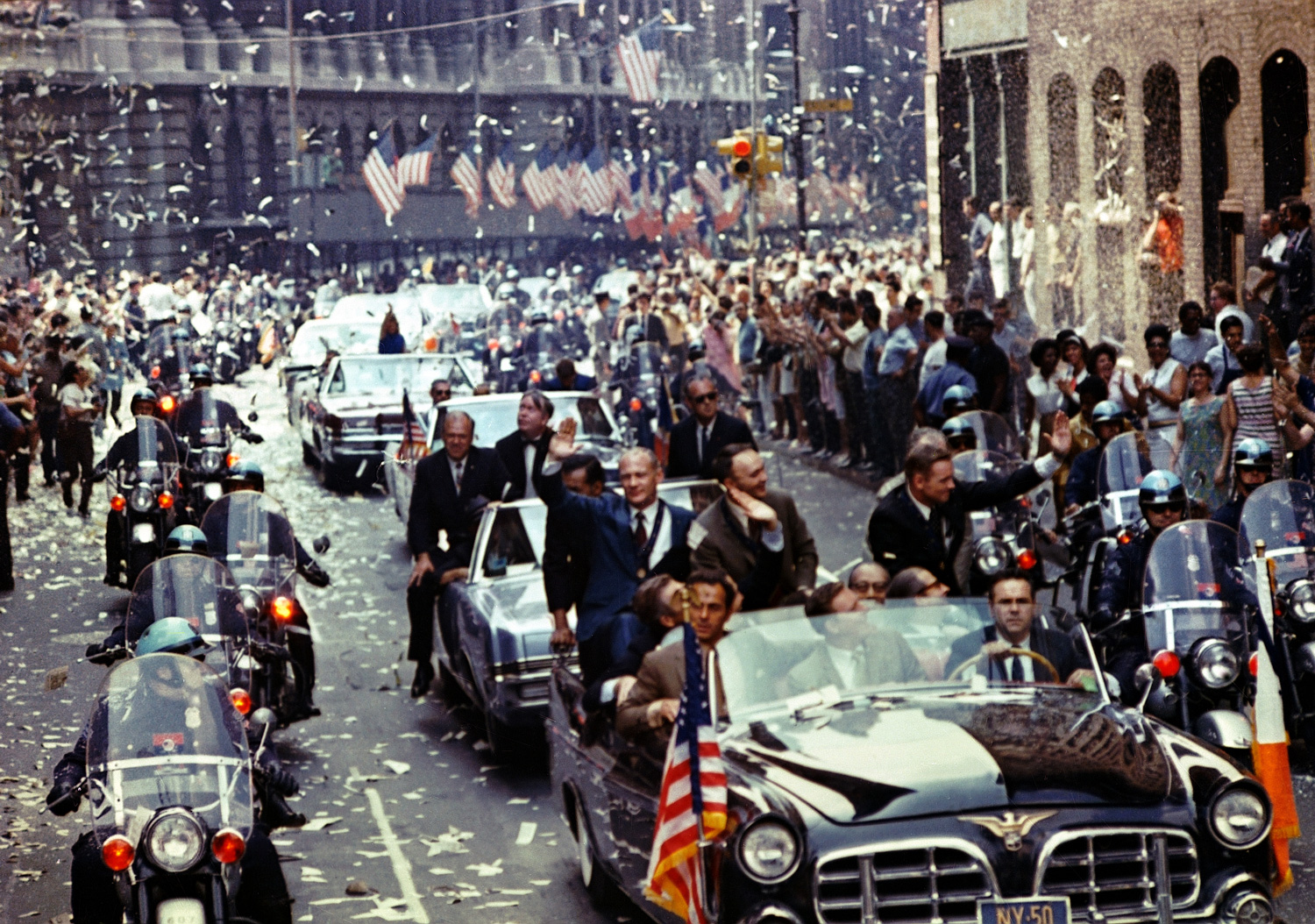It was one of those historic “Where were you when… ?” moments. Famed CBS news anchor Walter Cronkite reacted in awe and disbelief, removing his glasses much like he did when he somberly reported the death of President John F. Kennedy six years earlier. Only this time, Cronkite was smiling.
“Oh, boy! Whew! Boy!” Cronkite said with a chuckle, then he turned to his television co-host, former NASA astronaut Wally Schirra. “Wally, say something. I’m speechless.” Schirra, equally overwhelmed, appeared to wipe a tear. Yes, it was that big, that historic, that emotional.

Fifty years ago, on July 20, 1969, the first men landed on the Moon. Shortly thereafter, Neil Armstrong and Edwin “Buzz” Aldrin walked on it.
Reaching the Moon was once considered an inconceivable dream. Then, in 1961, JFK challenged his fellow countrymen to make it a reality, boldly setting a deadline to get there “before this decade is out.” America delivered. In a late-1960s world that sometimes seemed to be spinning out of control—there were race riots, assassinations, the Vietnam War, and anti-war protests—Apollo 11 brought unity. Better yet, reaching the Moon wasn’t just an American accomplishment. It was much bigger than that.
An estimated 500 million people—125–150 million of them in the U.S.—were glued to television broadcasts on that historic day. Appropriately, Armstrong got it right when his feet touched the Moon’s surface and he called the achievement “one small step for [a] man, one giant leap for mankind.”
Life would never be the same—for them or us.
When Armstrong, Aldrin, and command module pilot Michael Collins splashed safely into the Pacific Ocean on July 24, 1969, they were heralded as heroes. After being quarantined for 21 days to make sure they hadn’t brought back anything harmful, the three were celebrated from coast to coast and around the globe: 24 countries, 27 cities, 45 days.
So, what do the first men on the Moon have to do with cars? Frankly, in the whole scheme of things, not much. But leading up to the mission and again following the astronauts’ return, they had to get to work somehow. And they didn’t get there by rocket ship. They got there by car.
Everyone who knows anything about NASA knows the Chevrolet Corvette was the astronauts’ car of choice in the 1960s. After Corvette aficionado Alan Shepard became the first American in space on May 5, 1961, GM president Ed Cole presented him with a white 1962 Corvette. That ruffled some feathers—both at GM, where some thought it set a bad precedent, and at NASA, which prohibited astronauts from endorsing a product or company.
Jim Rathmann offered a solution. Rathmann, winner of the 1960 Indianapolis 500, owned a Chevrolet-Cadillac dealership in Melbourne, Florida, not far from the Kennedy Space Center. He convinced Cole to agree to a special GM program that allowed astronauts to lease up to two Chevys per year for $1 each.
Six of the seven original Mercury astronauts took full advantage of the program by leasing both a family wagon and a Corvette. Of those Corvettes, the only models that carried special paint schemes were the gold 1969 coupes driven by the crew of Apollo 12 (Charles “Pete” Conrad, Richard Gordon, and Alan Bean) and the red-white-blue 1971 ’Vettes driven by the crew of Apollo 15 (Dave Scott, Jim Irwin, and Alfred Worden).
All of the leased Corvettes were returned to Rathmann’s dealership at year’s end and were then sold to the public. Only a handful have resurfaced in the decades since; Texas collector Danny Reed owns three of them: a ’69 coupe driven by Bean, a blue ’71 driven by Scott, and a white ’71 driven by Worden. All three are on display at the National Corvette Museum in Bowling Green, Kentucky, through July 30. (Alan Shepard, by the way, became the only original Mercury astronaut to walk on the moon when he served as commander of Apollo 14. His 1968 Corvette convertible is also on display at the National Corvette Museum.)
What about the cars of the Apollo 11 crew? Aldrin was photographed getting out of his Corvette upon reporting for final training on July 9, 1969. Similar photos were taken of Armstrong and Collins, and although there isn’t a Corvette in sight, it’s likely both drove one.
A 1967 Sting Ray that Armstrong leased from Rathmann two years prior to walking on the Moon is now owned by retired Florida Sheriff Joe Crosby, who has preserved the car in near-original condition. It even has the GM “Protect-O-Plate” it came with, which reads, “N. A. Armstrong.” The car was originally purchased by a NASA employee the day after Armstrong turned it in (and then leased the silver ’68 mentioned above). Crosby bought it in 2012.
Aldrin enjoyed European cars in addition to the Corvettes he leased. While serving in the U.S. Air Force, he bought an Austin-Healey Sprite in Germany in the late 1950s and had it shipped back with him when he returned to the U.S. Aldrin also drove a Saab after leaving NASA in the early ’70s, and he publicly endorsed the technological advancements in the 1972 Volkswagen Beetle.
Less is known about Collins’ preference in cars, but he surely took part in the $1 lease program like his fellow astronauts.
Not that it matters. Armstrong, Aldrin, and Collins will never be lauded for their preference in cars anyway. They will be remembered for their courage on a historic mission that reached for the stars and united humanity. As Cronkite so aptly put it, “The date’s now indelible. It’s going to be remembered as long as man survives: July 20, 1969.”

















